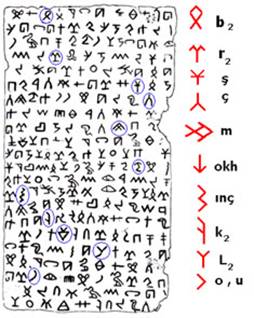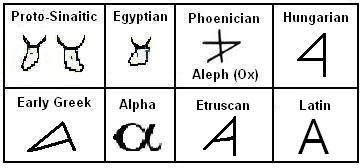|
After the disappearance of the Hittite empire by 1,000 BC the
Central Anatolian city-states lost their important position.
Instead the cities by the sea shores of western and southern
Anatolia became important and dominant. The two main reasons
for this change were the flourishing sea trade and the milder
climatic conditions of the Mediterranean and Aegean costs.
There is a
period of 500 years, from 1,000 BC to 500 BC, which is omitted
in the history of Anatolia. This period of half a millennium
is part of the forgotten past. It is a period of transition
during which the Indo-European languages replaced almost all
Altaic languages of the region. By 500 BC the Greek language
was the dominant language of western and southern Anatolia,
but few traces of the ancient culture and language continued
to exist as proper city names and locations.
I have
already mentioned in the previous chapter (Hittite
and Sumerian), that the Luwili language of Central
Anatolia transformed in time to Lycian of the southern coast.
The ancient Egyptians refer to the Lycians as the
Lukka and mention them
among the Sea People.
Luwili
is a name
referring to Ulu-illi
meaning “belonging to the holy city” in Altaic and
Lukka is similarly the
name of the Ulu-Ok
“the holy Ok” people. Lukkia,
can therefore be understood as meaning
Ulu-Ok-Öyü (the region
of the holy Ok), which became Lycia or Likia as time went by.
On the map of Chapter 12, The
Anatolian expansion, we can see the region called
Likia, located on the southern cost of present Turkey. The
Lycian alphabet is accepted to be a modified form of the Greek
alphabet, but it is quite the opposite that actually happened.
The Lycians, who were seafarers were trading with the
Phoenicians and brought the Pheonician alphabet to southern
Anatolia. The Phoenician alphabet was adapted for writing an
Afro-Asiatic language and did not fit Greek, which is an
Indio-European language. It was therefore modified first by
Lycians and then by the Greek speakers. But Poenician was
preceded by a script known as Proto-Phoenician. Below we see
an inscription in Proto-Phoenician, which is still a language
not yet deciphered (1).

There are
certain letters in this script (encircled in blue) that are
almost identical to some of the characters of the Orhun Valley
script (above right). The Orhun syllabary has been discussed
in Chapter 21, The
Orhun Valley Script.
The general belief exists that the Orhun script is an offshoot
of the Phoenician alphabet. But, as mentioned before, the
Orhun script is not an alphabet it is a syllabary,
furthermore, the evolution of writing systems started from
symbolic seals and after many trials finally reached the level
of phonetic letters. We already saw that the original location
of symbolic seals has been Central Asia, from which the
concept of recording thoughts dissipated in all directions.
Since
all Afro-Asiatic languages are well known and thoroughly
investigated, how come that the Proto-Phoenician script still
remains as a non-deciphered enigma? The reason being that,
most probably, the Proto-Phoenician script was designed for
recording an Altaic language that came to the region from the
north (see Chapter 18, Towards
Sümer and Elam). Trying to decipher the
Proto-Phoenician with the help of the Semitic languages will
be, to a large extent, unsuccessful.
The
Phoenician letters were originally Proto-Sinaitic pictographic
signs. They became letters after the concept of seal-writing
came to the region. Below we see the transformation of the
letter A. It was initially the picture of an ox-head
(2).
We already saw that the ox was a symbol representing the Ok
leader (see chapter 7, The
Minoan Culture). The bull symbolism came to the
Eastern Mediterranean region from both the south-east and also
from the north. This is why the first letter of the Phoenician
alphabet became aleph, meaning ox, which is a stylized form of
an ox head.

The
ancient Hungarians had also a script very similar to the Orhun
Valley script. This script was not borrowed from the Greek
script, as many still believe, but originated from the Ural
region. The Uralic languages developed from the bordering
Altaic languages as mentioned in Chapter 2,
Diversification of Languages.
Early Greek
letter A was similar to both the Hungarian as well as to the
Phoenician aleph. This is because the ancient north-western
Anatolian region, where Asiatic Thracians settled, was a
melting pot of northern and southern cultures speaking
languages that originated from a common source. The Semitic
people who remained in the vicinity of Canaan did not adopt
the Phoenician aleph but selected to keep the Orhun character
for “a” and “e”, changing it as shown below.

Canaan was
known as Kana’n or more understandably Khan’yn meaning
“belonging to the Khan” in Altaic. Languages spoken in Canaan
became extinct around the first millennium BC. They included
Phoenician, Punic, Ammonite, Moabite, Edomite and Hebrew.
Hebrew has been revived during the last century and is
presently the official language of Israel. Although the
residents of ancient Ugaritic did not consider themselves as
Canaanites, they were the first to develop an alphabetical
script and had a strong influence on Canaanites, and
especially on Phoenicians (see Chapter 20,
The Ugaritic script).
The reason for the disappearance of all Canaanite languages,
except Hebrew, needs to be investigated; because they make
part of our forgotten past. |